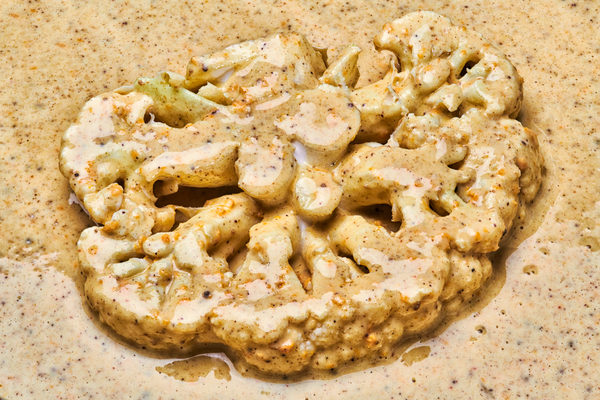When I’m craving a lunch that’s special but not fancy, or when lunchtime catches me by surprise, I head to the tiny restaurant Standard Fare in Berkeley. Run by Kelsie Kerr, one of the chefs at Chez Panisse who taught me to cook, Standard Fare is mostly kitchen; at lunchtime, customers turn the wide sidewalk into an ad hoc dining room, perching atop a row of metal stools with bowls of soup and focaccia sandwiches on their laps.
My lunch mantra is “as many vegetables as possible,” so I usually order the vegetarian sandwich, which is always piled high with whatever greens and vegetables catch Kerr’s eye at the farmers’ market, all enriched and brightened by generous doses of sauces and vinaigrettes. But when I stopped in a month or so ago, the daily special of cauliflower steaks with turmeric-spiced chickpeas sounded equally virtuous but more satisfying. Besides, I love caramel-sweet roasted cauliflower and will take any opportunity to eat it. I was typically harried, hungry and running late, so I felt lucky when I snagged one of the few inside seats. As I turned to scan the kitchen and gauge how long it might take the cooks to prepare my lunch, Kerr brought over a plate of fried cauliflower on a bed of fragrant spiced chickpeas, all showered with herbs and sizzled cumin seeds.
I hadn’t expected the cauliflower to be fried, but I was delighted by the way the tender, golden crust shattered in my mouth. Fried vegetables, often overbattered and undercooked, tend to disappoint me with their tough or soggy crusts. This cauliflower, though, was savory yet light. And though it had clearly been battered, it was also somehow sweet with the sort of browning that results from long, steady roasting. I looked back at the kitchen to thank the person who’d done such a nice job of preparing my lunch. But no one was frying anything! Fried food — especially when it’s battered — must be cooked to order and served immediately; otherwise it grows limp as it cools. And while there’s plenty of pleasure to be taken in sneaking a bite of cold, leftover fried chicken from the fridge late at night, you cannot serve soggy fried chicken — or soggy anything else — at a restaurant. Especially if you’re Kelsie Kerr, one of the most steadfast, exacting chefs the Bay Area has ever known.
On my way out, I asked Kerr for her recipe. I wanted to know how she had managed the technical feat of producing cauliflower that boasted the best characteristics of both roasted and fried. “Oh,” she responded with a knowing chuckle that sent her freckles dancing, “it’s Ella’s recipe.” I was stunned. I met Ella, Kelsie’s lithe, red-haired daughter, in 2001, when she could barely walk. It took me a moment to get used to the thought that she’s now 19 and able to develop recipes that hold muster in her mother’s kitchen. I begged Kerr to email me the recipe.
What she sent seemed simple enough. Made with a mixture of brown rice and tapioca flours, the batter lacked gluten, which explained the cauliflower’s delicate crust. When wheat flour is mixed with water, gluten strands develop and strengthen, giving structure to a batter or dough — a characteristic desirable in a crusty loaf of bread, but less so in a light pastry or crust.
When I tried the recipe at home, the cauliflower’s thin batter turned an amber lace as it fried in coconut oil. By the time I flipped each slice, the batter no longer covered the entirety of the second side, but those exposed bits of cauliflower — hugging the hot metal of the pan — took on a dark caramel color, growing extra sweet along the way.

Push the cauliflower steaks into the batter, turn to coat and allow to marinate for at least 3 minutes.CreditBobby Doherty for The New York Times. Food stylist: Maggie Ruggiero. Prop stylist: Noemi Bonazzi.
“When Ella was a high school sophomore,” Kerr told me when I called her for the cauliflower’s origin story, “she invited some friends over for dinner.” Not wanting to intrude where she sensed she was not welcome, Kerr kept quiet even as she watched her teenager battering and frying the cauliflower in advance. “I remember thinking there was no way it’d still be crispy that evening, but I didn’t say a word.” Then, when Ella served dinner, Kerr was taken aback. “I thought: Holy mackerel! This is delicious,” she recounted with delight. “I knew it was a keeper because it was a fried dish we could make ahead in batches at the restaurant and warm to order.”
Culinary progeny often end up in the kitchen alongside their parents, but I didn’t remember Ella’s ever showing an interest in cooking. I asked Kerr if Ella has always liked to cook. “She has, but she doesn’t like to take advice from her mother,” she answered dryly. “She prefers to learn from YouTube.” I wasn’t sure I heard Kerr right, so I asked her to clarify. “Yeah, she has all of these different YouTube cooks that she loves to watch.” Bursting into laughter, I marveled at the thought. Kerr has been cooking professionally since 1981 — probably longer than some of those YouTube chefs have been alive. She’s one of the most accomplished, knowledgeable chefs in the country. And yet, her daughter is partial to watching other folks cook online. As a student of cooking, I find this maddening. As the daughter of a steadfast, exacting mother of my own, I find it entirely relatable.
When I asked Kerr how it made her feel to be upstaged by YouTube, her generosity surprised me, “That’s Ella,” she said. “She’s so casual in her cooking. I’ve learned to trust her because she always does things I find suspicious, and they always turn out delicious.”
Recipe: Crispy Spiced Cauliflower Steaks




